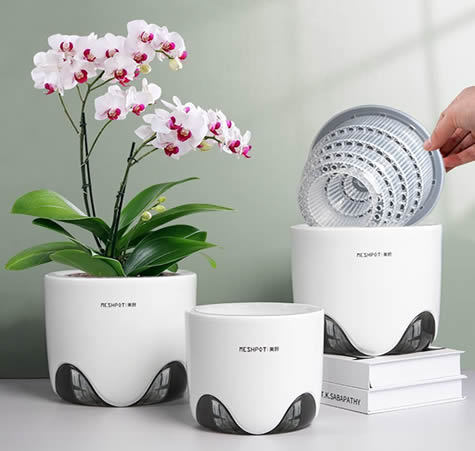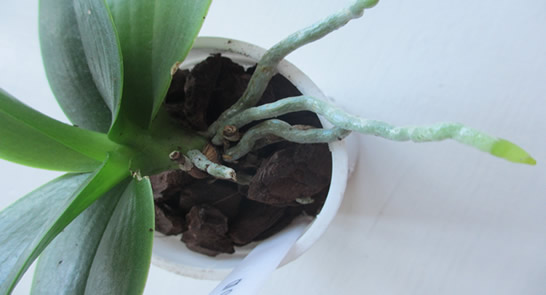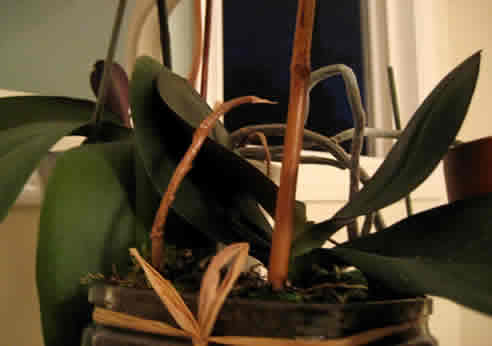Step into the enchanting world of orchids, where beauty meets simple but intricate care. Orchids, with their stunning blooms and unique allure, captivate the hearts of many plant enthusiasts. In this guide, we embark on a journey into the delicate realm of orchid care, unraveling the secrets to keeping these botanical gems flourishing in our homes.
Let’s dive into the orchid care adventure, where nurturing beauty is both an art and a joy.
Table of Contents
Orchid Care Guide
From the play of light and humidity to the dance of watering and feeding, we’ll demystify the art of orchid care.
Whether you’re a seasoned orchid enthusiast or a budding green thumb, join us in exploring the essential elements that contribute to the health and vibrancy of these exquisite plants.
Orchids are exquisite plants that require specific care to thrive.

Here are some of the most important aspects of orchid care:
- Potting Medium & Pot: Orchids often grow in a loose, well-draining mix, like bark or sphagnum moss. Repot when the medium breaks down or the orchid outgrows its container. A plastic or clay pot works best for orchids.
- Lighting: Provide bright, indirect light for most orchids. Avoid direct sunlight, especially during the hottest part of the day.
- Temperature: Orchids often thrive in temperatures between 60-75°F (15-24°C) during the day and slightly cooler at night.
- Humidity: Orchids prefer higher humidity levels, around 50-70%. Maintain humidity by misting, using humidity trays, or placing a humidifier nearby.
- Watering: Allow the orchid’s growing medium to approach dryness between waterings. Avoid overwatering, as orchid roots need air to prevent rot.
- Air Circulation: Ensure good air circulation around the orchid to prevent fungal and bacterial issues. Gentle airflow mimics their natural habitat.
- Fertilization: Feed orchids regularly with a balanced orchid fertilizer during the growing season. Reduce or stop fertilizing during dormant periods.
- Pruning: Remove spent blooms and trim damaged or dead roots. Pruning encourages new growth and redirects energy to healthy parts of the plant.
- Dormancy: Some orchids have a natural dormancy period. Adjust care by reducing water and fertilization during this time.
- Pest and Disease Control: Monitor for pests like aphids and scale. Treat issues promptly with insecticidal soap or neem oil. Prevent fungal problems by maintaining proper air circulation.
Remember that specific care requirements can vary depending on the orchid species, so it’s essential to identify the type of orchid you have for more accurate care.
Best orchid soil and pot
Selecting the right pot for your orchid is like choosing a dance floor.
Opt for containers with drainage holes to prevent waterlogged roots.
Ensure the pot suits your orchid’s growth habits, offering ample space.
It’s the potting ballet where your orchid takes center stage, twirling and thriving in its perfect performance space.
Due to better water retention a correctly sized plastic pot makes a great container for orchid growth.

Obviously plastic has a poor aesthetic and can detract from the beauty of these stunning air plants so placing the plastic inside a ceramic pot means you get all the benefits of the plastic without the detracting look.
Many orchid lovers will use these type of combo pots for their orchids.
For orchid soil embrace materials like bark or sphagnum moss for a well-draining mix.
Use a specially formulated orchid potting mix or mix your own using the following formula.
Orchid soil mix:
- Orchid Bark (50-70%): Provides aeration and drainage.
- Sphagnum Moss (20-40%): Retains moisture and adds organic matter.
- Perlite (10-20%): Enhances drainage and aeration.
- Charcoal (5-15%): Aids in preventing soil compaction and absorbs impurities.
- Coconut Husk Chips (5-15%): Promotes aeration and retains moisture.
- Fir Bark (5-10%): Adds structure and aids in aeration.
Orchid lighting requirements
Orchids are sun-soakers, but not the sunbathing kind. Give them bright, indirect light, like a gentle morning glow or filtered sunlight through net curtains.
You can also place them in any location that gets bright light as long as it is not strong direct sunlight.
Avoid direct sun rays; it’s a bit too much for these elegant blooms (see our guide on making orchids rebloom).
Find that sweet spot where they get just enough light to thrive without feeling the burn.
After all, in the world of orchids, it’s all about that perfect symphony of sunshine.
Orchid temperature requirements
Orchids prefer a Goldilocks approach to temperature— not too hot, not too cold, just right.
Aim for a cozy range between 60-75°F (15-24°C) during the day, with a slightly cooler touch at night.

It’s like setting the thermostat for the perfect dance floor where your orchids can groove and grow happily.
Remember, keeping it comfortable is the key to these delicate floral dancers’ heart.
Orchid humidity requirements
Orchids prefer good humidity.
Aim for that humidity sweet spot between 50-70%. This is much higher than the normal 30 – 40% levels in your home.
So, you therefore need to create a pampering environment with occasional misting or humidity trays. You can also use a plant humidifier – you can get perfectly adequate humidifiers for less than 10 bucks using the aforementioned link.
Think of it as a tropical retreat where your orchids can indulge in the moisture they love.
Keep it lush, keep it humid, and watch your orchids thrive in their personal spa paradise.
Orchid watering requirements
Orchids aren’t fans of waterlogged soil. Let their roots enjoy a bit of dryness between waterings.
Water them when the top inch of the medium feels dry, ensuring they sip moisture, not drown in water.
You can also use a soil water/moisture gauge for convenience. Insert the probe, as vertically as possible, into the pot. Push it down to a point half way between the edge of the container and the plant stem.
Do not push it down too far into the soil. About an inch is good enough. This will allow you to ascertain when the top layer of soil has dried out and the plant requires watering.
The numbers from 1 to 10 signify increasing moisture levels. Orchids do not like water soaked soil so this number should never be high even after you have watered the plant.
When the meter reads between 1 – 3 you should water the orchid.
It’s the delicate balance of hydration that keeps these beauties blooming. So ,focus on your orchid water scheduling if you want vibrant blooms.
Water wisely, and let your orchids revel in the perfect sip-and-dry routine.
Orchid roots require good air circulation
Orchids are air plants. Therefore their roots require good air circulation.
Orchids love a breath of fresh air, literally.
Ensure a gentle breeze circulates around their delicate leaves.

Mimic their natural habitat by providing good air circulation, preventing stuffiness and potential fungal issues.
It’s like giving your orchids a breath of the crisp mountain air they crave.
Keep it breezy, keep it fresh, and watch your orchids flourish in the airy embrace.
Orchid fertilizer
Orchids relish a well-balanced diet during their growing season.
Treat them to a diluted orchid fertilizer regularly, but not too much—it’s all about finesse.
Feed them with care, offering the nutrients they need without overwhelming their delicate palates.
I recommend you fertilize your orchids once every other two weeks, or at the least feed them once per month, but only after the blooms have dropped (read this if you want to know how to get your orchid blooms to last longer).
Orchid pruning encourages growth
Not only does pruning help with the aesthetic of your plant but it greatly helps your orchid stay healthy and promotes new growth.
Remove spent blooms and trim away any damaged or dead parts of the plant.
It’s like a refreshing haircut for your plants, promoting new growth and maintaining their elegant appearance.
Understanding the orchid dormancy phase
Some orchids love a winter waltz, entering a dormancy phase.
Orchids can remain dormant for 1 – 3 months.
During dormancy the plant will lose its blooms.

Don’t panic if the stem dries and begins to turn brown. As long you maintain the correct orchid care routine (remembering to fertilize the plant regularly) then your orchid will be fine.
Adjust your care routine by reducing water and fertilizer your plant, as outlined above, during this period.
It’s like letting your orchids take a cozy nap before their next big performance.
Orchid pest control
Keep a vigilant eye for sneaky pests like aphids and scale that love to fest on orchids.
Intervene with insecticidal soap or neem oil, which are very gentle on the plant but very effective remedies.
You can even use neem oil as a preventive measure as it will in no way harm the plant but will deter any nasty pests from going near your plant.
A well-protected orchid is a happy orchid.
Orchid Care Summary
Orchids thrive on a care routine that centers around simplicity with a little bit of indoor gardening finesse.
From light serenades to temperature waltzes, we’ve explored the secrets of their flourishing dance in the article above.

So, embrace the potting ballet, fine-tune your feeding finesse, and let your orchids sway to the dormancy dance and you’ll have a happy and vibrant plant for up to 20 years!
With these insights, you’re not just caring for orchids; you’re orchestrating a symphony of blossoms in your own botanical haven. Happy orchid growing!

